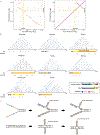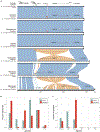Integrated analysis of the complete sequence of a macaque genome
- PMID: 40011769
- PMCID: PMC12003069
- DOI: 10.1038/s41586-025-08596-w
Integrated analysis of the complete sequence of a macaque genome
Abstract
The crab-eating macaques (Macaca fascicularis) and rhesus macaques (Macaca mulatta) are pivotal in biomedical and evolutionary research1-3. However, their genomic complexity and interspecies genetic differences remain unclear4. Here, we present a complete genome assembly of a crab-eating macaque, revealing 46% fewer segmental duplications and 3.83 times longer centromeres than those of humans5,6. We also characterize 93 large-scale genomic differences between macaques and humans at a single-base-pair resolution, highlighting their impact on gene regulation in primate evolution. Using ten long-read macaque genomes, hundreds of short-read macaque genomes and full-length transcriptome data, we identified roughly 2 Mbp of fixed-genetic variants, roughly 240 Mbp of complex loci, 16.76 Mbp genetic differentiation regions and 110 alternative splice events, potentially associated with various phenotypic differences between the two macaque species. In summary, the integrated genetic analysis enhances understanding of lineage-specific phenotypes, adaptation and primate evolution, thereby improving their biomedical applications in human disease research.
© 2025. The Author(s), under exclusive licence to Springer Nature Limited.
Conflict of interest statement
Competing interests: E.E.E. is a scientific advisory board member of Variant Bio. The other authors declare no competing interests.
Figures














Update of
-
Comparative genomics of macaques and integrated insights into genetic variation and population history.bioRxiv [Preprint]. 2024 Apr 8:2024.04.07.588379. doi: 10.1101/2024.04.07.588379. bioRxiv. 2024. Update in: Nature. 2025 Apr;640(8059):714-721. doi: 10.1038/s41586-025-08596-w. PMID: 38645259 Free PMC article. Updated. Preprint.
References
MeSH terms
Grants and funding
LinkOut - more resources
Full Text Sources
Other Literature Sources
Miscellaneous

